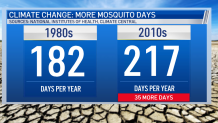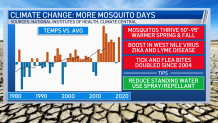With our increased temperatures we have seen an increase in the amount of days mosquitoes and ticks are active. In the 1980s there was an average of 182 mosquito days per year and in the 2010s we have increased to 217 days, a 35 day increase.

As you can see in the picture below, the most warming has happened over the past decade where temperatures have surged and mostly stayed above average. So, how does our warmer weather relate to mosquitoes?
Well, they tend to thrive in warmer weather from 50° to 95° in the Spring and Fall. This warmer weather pattern has boosted tick and flea bites which have doubled since 2004. West Nile Virus, Zika and Lyme disease have also increased.

So what can you do now to lower your chance of getting bit? Keep your grass short and firewood in a dry place. Also, make sure there is no standing water around your house where mosquitoes can thrive.
You can find out more about how the Bay Area climate is changing in a series of stories the Microclimate Weather Team worked on across the Bay Area.
Get a weekly recap of the latest San Francisco Bay Area housing news. Sign up for NBC Bay Area’s Housing Deconstructed newsletter.


